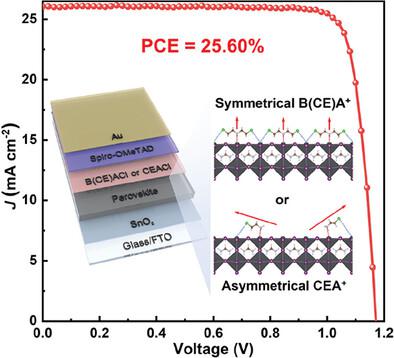当前位置:
X-MOL 学术
›
Adv. Mater.
›
论文详情
Our official English website, www.x-mol.net, welcomes your feedback! (Note: you will need to create a separate account there.)
Tailoring Perovskite Surface Potential and Chelation Advances Efficient Solar Cells
Advanced Materials ( IF 29.4 ) Pub Date : 2024-03-13 , DOI: 10.1002/adma.202310080 Wenlong Shao 1 , Haibing Wang 2 , Shiqiang Fu 1 , Yansong Ge 1 , Hongling Guan 1 , Chen Wang 1 , Cheng Wang 1 , Ti Wang 1 , Weijun Ke 1 , Guojia Fang 1, 2
Advanced Materials ( IF 29.4 ) Pub Date : 2024-03-13 , DOI: 10.1002/adma.202310080 Wenlong Shao 1 , Haibing Wang 2 , Shiqiang Fu 1 , Yansong Ge 1 , Hongling Guan 1 , Chen Wang 1 , Cheng Wang 1 , Ti Wang 1 , Weijun Ke 1 , Guojia Fang 1, 2
Affiliation

|
Modifying perovskite surface using various organic ammonium halide cations has proven to be an effective approach for enhancing the overall performance of perovskite solar cells. Nevertheless, the impact of the structural symmetry of these ammonium halide cations on perovskite interface termination has remained uncertain. Here, this work investigates the influence of symmetry on the performance of the devices, using molecules based on symmetrical bis(2-chloroethyl)ammonium cation (B(CE)A+) and asymmetrical 2-chloroethylammonium cation (CEA+) as interface layers between the perovskite and hole transport layer. These results reveal that the symmetrical B(CE)A+ cations lead to a more homogeneous surface potential and more comprehensive chelation with uncoordinated Pb2+ compared to the asymmetrical cations, resulting in a more favorable energy band alignment and strengthened defect healing. This strategy, leveraging the spatial geometrical symmetry of the interface cations, promotes hole carrier extraction between functional layers and reduces nonradiative recombination on the perovskite surface. Consequently, perovskite solar cells processed with the symmetrical B(CE)A+ cations achieve a power conversion efficiency (PCE) of 25.60% and retain ≈91% of their initial PCE after 500 h of maximum power point operation. This work highlights the significant benefits of utilizing structurally symmetrical cations in promoting the performance and stability of perovskite solar cells.
中文翻译:

定制钙钛矿表面电势和螯合可提高高效太阳能电池的性能
使用各种有机卤化铵阳离子修饰钙钛矿表面已被证明是提高钙钛矿太阳能电池整体性能的有效方法。然而,这些卤化铵阳离子的结构对称性对钙钛矿界面终止的影响仍然不确定。在这里,这项工作研究了对称性对器件性能的影响,使用基于对称双(2-氯乙基)铵阳离子(B(CE)A + )和不对称2-氯乙基铵阳离子(CEA +)的分子作为界面层钙钛矿和空穴传输层之间。这些结果表明,与不对称的阳离子相比,对称的B(CE)A +阳离子导致更均匀的表面电势以及与不配位的Pb 2+更全面的螯合,从而导致更有利的能带排列并增强缺陷愈合。该策略利用界面阳离子的空间几何对称性,促进功能层之间的空穴载流子提取,并减少钙钛矿表面的非辐射复合。因此,用对称 B(CE)A +阳离子处理的钙钛矿太阳能电池实现了 25.60% 的功率转换效率 (PCE),并在最大功率点运行 500 小时后保留了约 91% 的初始 PCE。这项工作强调了利用结构对称的阳离子在提高钙钛矿太阳能电池的性能和稳定性方面的显着优势。
更新日期:2024-03-18
中文翻译:

定制钙钛矿表面电势和螯合可提高高效太阳能电池的性能
使用各种有机卤化铵阳离子修饰钙钛矿表面已被证明是提高钙钛矿太阳能电池整体性能的有效方法。然而,这些卤化铵阳离子的结构对称性对钙钛矿界面终止的影响仍然不确定。在这里,这项工作研究了对称性对器件性能的影响,使用基于对称双(2-氯乙基)铵阳离子(B(CE)A + )和不对称2-氯乙基铵阳离子(CEA +)的分子作为界面层钙钛矿和空穴传输层之间。这些结果表明,与不对称的阳离子相比,对称的B(CE)A +阳离子导致更均匀的表面电势以及与不配位的Pb 2+更全面的螯合,从而导致更有利的能带排列并增强缺陷愈合。该策略利用界面阳离子的空间几何对称性,促进功能层之间的空穴载流子提取,并减少钙钛矿表面的非辐射复合。因此,用对称 B(CE)A +阳离子处理的钙钛矿太阳能电池实现了 25.60% 的功率转换效率 (PCE),并在最大功率点运行 500 小时后保留了约 91% 的初始 PCE。这项工作强调了利用结构对称的阳离子在提高钙钛矿太阳能电池的性能和稳定性方面的显着优势。



























 京公网安备 11010802027423号
京公网安备 11010802027423号